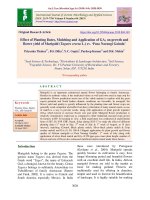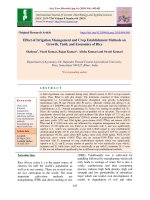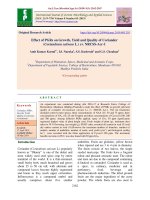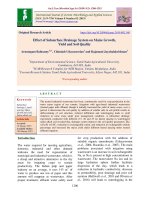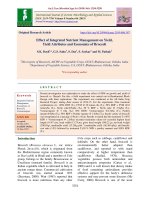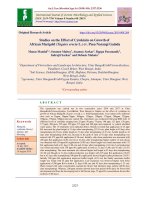Effect of different growing media on seedling growth parameters and economics of papaya (Carica papaya L) cv. Pusa delicious
Bạn đang xem bản rút gọn của tài liệu. Xem và tải ngay bản đầy đủ của tài liệu tại đây (184.03 KB, 9 trang )
Int.J.Curr.Microbiol.App.Sci (2017) 6(6): 2964-2972
International Journal of Current Microbiology and Applied Sciences
ISSN: 2319-7706 Volume 6 Number 6 (2017) pp. 2964-2972
Journal homepage:
Original Research Article
/>
Effect of Different Growing Media on Seedling Growth Parameters and
Economics of Papaya (Carica papaya L) cv. Pusa Delicious
A.K. Meena, O.P. Garhwal, Arun Kumar Mahawar* and S.P. Singh
Department of Horticulture, SKN College of Agriculture, Jobner – 303329,
Jaipur (Rajasthan), India
*Corresponding author
ABSTRACT
Keywords
Papaya, Cocopeat,
Vermiculite,
Vermicompost,
Growth and net
returns.
Article Info
Accepted:
29 May 2017
Available Online:
10 June 2017
The experiment was conducted to study the “Effect of different growing media on seedling
growth parameters and economics of papaya (Carica papaya L) cv. Pusa Delicious” at
Departmental Nursery and Horticulture farm, S.K.N. College of Agriculture, Jobner,
Rajasthan during 2014-15. The treatments were prepared with combination between types
of media with level of cocopeat having 50 polybags in each treatment and replication. The
results showed that the medium of soil + vermicompost + vermiculite (1:1:1) with 2 cm
cocopeat at top of polybags (T5) found to be the best and significantly superior medium for
the growth of papaya seedlings as it gave the highest growth parameters in terms of stem
girth (4.49 mm and 5.90 mm at 30 and 45 DAS, respectively), number of roots (16.06),
root length (9.07 cm), fresh weight of shoot and root (4.66 g and 1.04 g, respectively) and
least root: shoot ratio (0.22). This treatment also recorded highest survival percentage
(94.67) which reduced mortality of plants and produced healthy seedlings with highest net
returns (Rs 7401/1000 seedlings). Further, it can be concluded that use of soil +
vermicompost + vermiculite (1:1:1) with 2 cm cocopeat layer at top of polybags is worth
recommendable as both of highest performance of seedling growth of papaya and net
returns (Rs 7401/1000 seedlings) which was significantly superior over rest of the
treatments.
Introduction
Papaya (Carica papaya L.) is very
wholesome, refreshing and delicious fruit
belongs to caricaceae family and its native
place is tropical America. Papaya is also
called papaw or pawpaw, an ideal fruit for
growing in kitchen gardens, backyards of
homes as well as in field, especially near the
cities or big towns. It is also grown
extensively as a filler plant in orchards. And
rich source of vitamins. It contains about
2500 IU of vitamin A and 85 mg of vitamin C
per 100 g of pulp. It is also fairly rich in
calcium and other minerals. It has high
medicinal value. Papain prepared from dried
latex of its immature fruits is used in meat
tenderizing, manufacture of chewing gum,
cosmetics, degumming of natural silk and to
give shrink resistance to wool. Papaya juice
has an in vitro antiproliferative effect on liver
cancer cells, possibly due to lycopene (Asmah
et al., 2002). Papaya is a quick growing,
continuous fruiting, evergreen plant and
requires a good fertile soil or growing media
for better growth, development and quality of
2964
Int.J.Curr.Microbiol.App.Sci (2017) 6(6): 2964-2972
fruits. The use of suitable growing media or
substrates for sowing of seeds directly affects
the germination, development and functional
rooting system. A good growing medium
provides sufficient anchorage or support to
the plant, serves as reservoir for nutrients and
water, allow oxygen diffusion to the roots and
permit gaseous exchange between the roots
and atmosphere outside the root substrate
(Abad et al., 2002). The quality of seedlings
is very much influenced by growing media
under nursery (Agbo and Omaliko, 2006).
The quality of seedlings obtained from a
nursery influences re-establishment in the
field and the eventual productivity of an
orchard (Baiyeri, 2006).
Growing media are an integral part of most
horticultural production systems. Soil,
vermicompost, vermiculite, perlite, cocopeat
etc. are included as different growing media
in the present study. The soil is generally used
as a basic medium because it is cheapest and
easy to procure supplementing of the soil
which is aimed to make media more porous
while the organic matter (Vermicompost,
Vermiculite, Perlite, Cocopeat) is added so as
to enrich adequate nutrients for the
seedlings.). A growing medium is a substance
through which roots grow to extract water &
nutrients. The growing medium also plays an
important role in seed germination not only it
does act as a support, but also a source of key
nutrients for plant growth. The composition of
the medium influences the quality of the
seedlings (Wilson et al., 2001). Perlite and
vermiculite have been used for years to
amend professional potting soils made from
peat moss (called "soilless" mixes or artificial
soils because they literally contain no soil).
They also have been used in outdoor mixes, in
turfgrass and outdoor planting for gardens.
Essentially perlite and vermiculite are used in
the horticultural industry because they both
provide aeration and drainage, they can retain
and hold substantial amount of water and later
release it as needed. They are sterile and free
from diseases, having a fairly neutral pH
(especially perlite which is neutral), and
readily available, non-toxic, safe to use, and
relatively
inexpensive.
Likewise,
Vermicompost refers to a mixture of worm
casting, organic material, humus, living
earthworms, their cocoons and other
organisms. Earthworm reduces C: N ratio,
increase humic acid content, cation exchange
capacity and water soluble carbohydrates
(Talashilkar et al., 1999). Similarly, cocopeat
is an agricultural by-product obtained after
the extraction of fibre from the coconut husk
(Abad et al., 2002). As a growing medium, it
can be used to produce a number of crop
species with acceptable quantity in the tropics
(Yahaya and Mohklas, 1999; Yau and
Murphy, 2000). Cocopeat is considered as a
growing medium component with acceptable
pH, EC and other chemical attributes (Abad et
al., 2002). Cocopeat has good physical
properties, high total pore space, high water
content, low shrinkage, low bulk density and
slow biodegradation (Evans et al., 1996 and
Prasad, 1997).
Materials and Methods
Climate and weather conditions
The experiment was laid out at Departmental
Nursery and Horticulture farm, S.K.N.
College of Agriculture, Jobner, Rajasthan
during year 2014-15. The climate of Jobner is
typically semi-arid, characterized by extremes
of temperature both in summer and winter,
low rainfall and moderate relative humidity.
Weather parameters play an important role in
the growth and developmental process of the
crop hence it is important to present climatic
variables. The mean daily maximum and
minimum temperature during the growing
season of papaya fluctuated between 36.3 and
2.40 C, respectively and relative humidity
ranged from 47 to 82 per cent. The mean
2965
Int.J.Curr.Microbiol.App.Sci (2017) 6(6): 2964-2972
value of evaporation from USWB class pan
ranged from 2.3 to 7.3 hrs mm. There was a
total
rainfall
of
44
mm
during
experimentation.
The present experiment consists of 10
treatment
combinations
with
three
replications was laid out in CRD with
allocation of treatments. The treatments with
their combinations and symbols are described
as under:- T0 - Soil + Vermicompost (1:1), T1
- Soil + Vermicompost (1:1) with 1 cm
Cocopeat at top, T2 - Soil + Vermicompost
(1:1) with 2 cm Cocopeat at top, T3 - Soil +
Vermicompost + Vermiculite (1:1:1), T4 Soil + Vermicompost + Vermiculite (1:1:1)
with 1 cm Cocopeat at top, T5 - Soil +
Vermicompost + Vermiculite (1:1:1) with 2
cm Cocopeat at top, T6 - Soil +
Vermicompost + Perlite (1:1:1), T7 - Soil +
Vermicompost + Perlite (1:1:1) with 1 cm
Cocopeat at top, T8 - Soil + Vermicompost +
Perlite (1:1:1) with 2 cm Cocopeat at top, T9 Soil + Vermicompost + Vermiculite + Perlite
(1:1:1:1). Seeds of papaya cv. „Pusa
Delicious‟ were procured from Jaipur in 10 g
air-tight polythene packing. “Pusa Delicious”is a gynodioecious variety of papaya with 100
% productive plants with good fruit yield and
quality having excellent taste and good
flavour also.
The experimental media consisted of ten
different combinations of soil, vermicompost,
perlite and vermiculite with two different (1
cm and 2 cm) layer of cocopeat on the top of
the polybags. A mixture of growing media
was prepared and polythene bags of 10x15 cm
size were filled with mixture as per
treatments. Polythene bags holes were made
for leakage for gases. Seeds (one in each
polybag) were sown at approximately 10-15
mm deep in the different growing.
The polybags were immediately irrigated after
sowing and this was repeated every day with
light irrigation for each polybags until
seedling emergence takes place. After the
completion of germination, the polybags were
lightly irrigated once every two days.
Treatment evaluations/measurements
Data on all seedling growth parameters were
measured at 30 days and 45 days after sowing
in ten randomly-selected seedlings of each
treatment.
Survival percentage
Survival percentage of papaya seedlings was
observed by transplanting them in the field.
Ten plants of each treatment were
transplanted in field and survivality up to 10
days after transplanting was calculated using
the formulae as:
Total number of surviving seedling
Survival percentage = --------------------- x 100
Total number of transplanted seedling
Economics of treatments and statistical
analysis
The expenditure incurred on all operations
and cost of materials and inputs applied to
each treatment were taken into account to
determine cost of cultivation while the gross
return were calculated by multiplying the
number of plants of each treatments with sale
price of papaya seedlings.
The net returns were calculated by deducting
cost of raising the seedlings from gross return
for respective treatment. Data collected on
different aspects of papaya viz. seedling
growth parameters were subjected to
statistical analysis (Panse and Sukhatme,
1985).
Significance of difference between means of
data was tested through “F” test and critical
difference (CD) was worked out wherever,
2966
Int.J.Curr.Microbiol.App.Sci (2017) 6(6): 2964-2972
“F” value was found to be significant for
treatment effect. To elucidate the nature and
magnitude of treatment effects summary table
along with SEm± and CD at 5% are given in
text of chapter “Experimental Results” and
their analysis of variance are given in
appendices at the end.
nutritional factors (Sahni et al., 2008). It may
be due to better nutrient availability leading to
higher production of photosynthetically
functional leaves in these treatments finally
resulting in better girth of seedling (Borah et
al., 2008). Similar results were also obtained
by Parasana et al., (2014) in mango.
Results and Discussion
The data pertaining to root character in table 1
clearly indicated that maximum (9.07 cm) and
significantly higher root length and higher
number of roots per plant (16.06) were
observed in treatment T5 and proved
significantly superior over rest of the
treatments except T4 which is at par to
treatment T5 in that regard at 45 DAS of
papaya seedling. However, the minimum
number of roots (10.20) and minimum root
length (6.50 cm) were recorded under the
treatment T0 i.e. soil + vermicompost (1:1).
The increase in number of roots per plant was
registered 57.45 and 24.02 per cent higher in
treatment T5 (Soil + Vermicompost
+Vermiculite (1:1:1) with 2 cm Cocopeat at
top), over treatment T0 and T6, respectively
and treatment T5 registered 39.54 per cent
higher root length of Papaya seedlings than
treatment T0 i.e. soil + vermicompost (1:1).
From the data of present experimentation also
reported that significant differences among
the different treatments with regard to
seedling growth characters like maximum
number of roots per plant and maximum root
length were observed in T4 and T5 treatments
with soil+ vermicompost+ vermiculite+
cococpeat media. These results are akin to the
findings of Bhardwaj (2014) and Abirami
(2010) who suggested that since coir dust is
low in nutrients when mixed with
vermicompost and vermiculite provides a
better growth medium for papaya plant
establishment. However, the air filled porosity
(AFP), easily available water (EAW) and
aeration of soil and vermicompost were not at
the recommended level, which in turn limit
the root growth and lowered the water holding
capacity. Therefore, the medium with
Effect of different growing media on the
growth parameters
A perusal of data given in table 1 revealed
that stem girth per plant was also significantly
influenced by use of different growing media
at 30 and 45 DAS of papaya seedlings. The
maximum stem girth per plant at 30 and 45
DAS (4.49 mm and 5.90 mm, respectively)
was recorded with treatment T5 (Soil +
Vermicompost + Vermiculite (1:1:1) with 2
cm Cocopeat at top). However, minimum was
found under T0 (3.11 mm and 3.96 mm,
respectively). The treatment T5 significantly
proved the best over rest of the treatments
except T4 which was found to be statistically
at par with T5. The increase in stem girth of
papaya seedling under T5 was noted 48.84
and 48.99 per cent higher over T0 at 30 and 45
DAS, respectively. Significant differences
were observed among the different treatments
with regard to seedling growth character like
maximum stem girth were observed in
treatment T5 which were at par with treatment
T4. As discussed that vermicompost,
vermiculite and cocopeat provides adequate
nutrients and enhances both the physical and
biological properties and the water holding
capacity of soil (Soegiman, 1982). A similar
result was also reported by Bhardwaj, (2014).
Further,
combined
application
of
vermicompost and cocopeat with vermiculite
in the treatment T5 showed significant effect
on seedling growth parameters and plant
biomass probably due to the synergistic
combinations of these factors improving the
physical conditions of the media and
2967
Int.J.Curr.Microbiol.App.Sci (2017) 6(6): 2964-2972
vermicompost, cocopeat and vermiculite were
more suitable than soil and vermicompost and
perlite. Vermicompost represented hormonelike activity and increased the number of
roots, thereby, enhancing nutrient uptake as
well as plant growth and development
(Alvarez and Grigera, 2005). Similar results
were obtained by Yadav et al., (2012) in acid
lime using soil: sand: vermicompost:
vermiculite: cocopeat (1:1:1:1:1) media.
It is amply clear from data (Table 1) that use
of different growing media had significant
effect on fresh weight of roots of papaya
seedlings and total weight of plant at 45 days
after sowing and fresh weight of Papaya
shoots. The maximum fresh weight of shoot
(4.66 g), fresh weight of root (1.04 g) and
maximum and significantly higher total plant
weight (5.70 g) were recorded under
treatment T5 (Soil + Vermicompost +
Vermiculite (1:1:1) with 2 cm Cocopeat at
top), whereas, the minimum fresh weight of
shoot (1.97 g), fresh weight of root (0.62 g)
and total weight of plant were recorded under
the treatment T0 i.e. soil + vermicompost
(1:1). The treatment T5 was significantly
superior over rest of the treatments, but found
to be statistically at par with T4.
However, the use of treatment T5 i.e. Soil +
Vermicompost + Vermiculite (1:1:1) with 2
cm Cocopeat at top registered 136.55 per cent
higher fresh weight of shoot and total plant
weight of papaya seedlings over treatment T0
(soil + vermicompost (1:1) and noted 67.74
per cent higher fresh weight of roots of
papaya seedling over treatment T6 i.e. soil +
vermicompost + perlite (1:1:1). This may be
due to favorable conditions for better growth
of the seedling, particularly for good
development of a root system in earthen
media there was less coiling of roots was
taken place. Due to more root growth,
seedlings absorbed more nutrients and thus
produced seedlings with more growth of
leaves and increase the photosynthesis which
leads to increase fresh weight of seedlings and
there by dry weight of seedlings. The
beneficial effect on root growth parameters
due to media soil + compost + cocopeat
(1:1:1) might be due to improved soil texture,
structure, porosity, water holding capacity,
activity of useful soil micro fauna and flora,
maintained soil temperature and improved
soil health and nutrient status of medium
(Hartmann and Kester, 1997). Further the
compost also provides close contact between
seed and media increases steady moisture
supply facilitates root respiration and
encourages overall root growth (Chatterjee
and Choudhari, 2007). These findings also
indicated that the effect of vermicompost on
plant growth and development were not only
nutritional
but
also
hormonal
and
biochemical. The vermicompost increased
leaf area and biomass in various plants have
been reported by some researchers (Bachman
and Metzger, 2008) which are in agreement
with findings of current study. Results are
obtained in accordance with the results of
earlier worker Yadav et al., (2012) in acid
lime.
Root: shoot ratio
A perusal of data given in table 1 revealed
that use of different growing media brought
out perceptible variation in root: shoot ratio of
papaya seedling at 45 days after sowing.
Minimum and significantly lower root: shoot
ratio (0.22) was observed in treatment T4 and
T5 over other treatments except treatment T9
which was found to be statistically at par with
T4 and T5 during the course of
experimentation. However, higher root: shoot
ratio (0.36) was found in treatment T1 i.e. soil
+ vermicompost (1:1) with 1 cm cocopeat at
top. Treatment T4 and T5 registered 38.89 per
cent lower root: shoot ratio as compared to
treatment T1. Vermicompost provides
adequate nutrients and enhances both physical
properties and water holding capacity.
2968
Int.J.Curr.Microbiol.App.Sci (2017) 6(6): 2964-2972
Table.1 Effect of different growing media on seedling growth and yield parameters and economics of papaya
Treatments
Stem girth
(mm)
Number
of roots
Root
length
(cm)
Fresh
weight of
shoot (g)
Fresh
weight of
roots (g)
Total
weight of
plant (g)
Root:
shoot
ratio
Survival
(%)
Net
returns
(Rs)
T0 - Soil + Vermicompost (1:1)
30
DAS
3.11
45
DAS
3.96
10.20
6.50
1.97
0.63
2.60
0.32
79.33
6244
T1 - Soil + Vermicompost (1:1) with 1 cm
3.42
4.68
13.23
6.85
2.10
0.76
2.86
0.36
84.20
6811
3.63
4.96
15.59
7.65
2.70
0.79
3.49
0.29
86.09
7046
3.93
5.12
15.29
7.73
3.82
0.93
4.75
0.24
88.67
5791
4.30
5.73
15.81
8.84
4.41
0.99
5.40
0.22
91.67
7031
4.49
5.90
16.06
9.07
4.66
1.04
5.70
0.22
94.67
7401
T6 - Soil + Vermicompost + Perlite (1:1:1)
3.29
4.72
12.95
7.15
2.00
0.62
2.62
0.31
80.33
0290
T7 - Soil + Vermicompost + Perlite (1:1:1)
3.95
4.82
13.10
8.05
2.74
0.67
3.41
0.24
82.67
0945
4.14
4.96
15.25
8.15
2.85
0.75
3.60
0.26
83.67
1751
4.09
5.68
15.36
8.72
3.73
0.84
4.57
0.23
86.33
0772
SEm±
0.07
0.10
0.21
0.18
0.08
0.01
0.10
0.005
01.48
116.48
CD (P = 0.05)
0.23
0.29
0.62
0.55
0.25
0.05
0.30
0.017
04.38
343.63
Cocopeat at top
T2 - Soil + Vermicompost(1:1) with 2 cm
Cocopeat at top
T3 - Soil + Vermicompost + Vermiculite
(1:1:1)
T4 - Soil + Vermicompost + Vermiculite
(1:1:1) with 1 cm Cocopeat at top
T5 - Soil + Vermicompost + Vermiculite
(1:1:1) with 2 cm Cocopeat at top
with 1cm Cocopeat at top
T8 - Soil + Vermicompost + Perlite (1:1:1)
with 2 cm Cocopeat at top
T9 - Soil + Vermicompost + Vermiculite +
Perlite (1:1:1:1)
2969
Int.J.Curr.Microbiol.App.Sci (2017) 6(6): 2964-2972
Combined application of vermicompost and
cocopeat have too showed significant effect
on seedling growth and plant biomass,
perhaps due to the synergistic effect of both
these factors. This result is in line with
findings of Campos Mota et al., (2009) and
Abirami et al., (2010) who suggested that
since coir dust was low in nutrients, mixed
with vermicompost it provides a better growth
medium for plant establishment. However, air
filled porosity, easily available water and
aeration of vermicompost and Farm Yard
Manure were not at the recommended level
which, in turn, limited root growth and
lowered water-holding capacity. Therefore,
medium with vermicompost and cocopeat is
better suited than vermicompost alone,
because of its better physical properties and
higher nutrient levels.
It is apparent from data (Table 1) that use of
growing media significantly enhanced the
survival percentage of papaya seedlings at 10
days after transplanting in field. The
maximum survival percentage (94.67) was
recorded with treatment T5 (Soil +
Vermicompost + Vermiculite (1:1:1) with 2
cm Cocopeat at top), while minimum was
observed under T0 (79.33).
The treatment T5 was significantly superior
over T0 followed by T6, T7, T8, T1, T2, T9 and
T3 but found to be statistically at par with T4.
It registered 19.34 per cent higher survival
percentage over treatment T0. Therefore, from
the past findings, the medium with
vermicompost, cocopeat and vermiculite were
more suitable in case of root growth and
lowered the water holding capacity than soil
and vermicompost and perlite.
These treatment combinations were also
helpful in reducing damping off disease in
seedling due to proper aeration in root zone of
the seedling and provide maximum survival
per cent of seedlings because of the better
physical properties and enhanced nutrient
level in T4 and T5 treatments, growth of
seedlings was too fast. It might be due to
improved soil porosity, better water contents,
drainage, soil permeability and moisture
availability.
The seedling ultimately gained better growth
and development. It seems that good physical
and biological conditions in cococpeat and
vermicompost had positive effect on root
development, which is helpful in increased
survival percentage of seedling in main field
after transplanting. Beneficial effect of
cocopeat on root system was also observed on
nutmeg seedling by Abirami et al., (2010).
This may be also due to this favorable media
has suitable physical properties and good
water holding capacity that supports the
vigrous growth of seedlings, better growth of
the
seedling,
particularly for
good
development of a root system. These results
are in close agreement with Shamet et al.,
(1994).
Economics
It is evident from the data (Table 1) that
growing media Soil + Vermicompost +
Vermiculite (1:1:1) with 2 cm cocopeat at top
(T5) had maximum and significantly higher
net returns in papaya seedlings (Rs 7401 per
1000 seedlings) over rest of the treatments.
However, the minimum net returns (Rs 290
per 1000 seedlings) was recorded under the
treatment T6 followed by T9, T7 and T8.
Application of treatment T5 for preparation of
papaya seedlings are profitable and showed
maximum net return.
This might be due to fact that highest seedling
vigour was obtained under this treatment. The
higher net returns under this treatment could
be ascribed to the lesser cost of treatments
and higher healthy seedling. Similar results
have also been reported by Bhardwaj (2013).
2970
Int.J.Curr.Microbiol.App.Sci (2017) 6(6): 2964-2972
It can be concluded that the performance of
growing
media
containing
Soil+
Vermicompost+ Vermiculite (1:1:1) with
Cococpeat layers at top were found
significantly superior over rest of the
treatments in all the growth parameters of
papaya seedlings. Further, use of growing
media as treatment T5 i.e. Soil+
Vermicompost+ Vermiculite (1:1:1) with 2cm
Cococpeat at top is worth recommendable as
it
fetched
comparable
net
returns
(Rs7401/1000
seedlings)
which
was
significantly superior to rest of the treatments.
References
Abad,
M., Noguere, P., puchades, R.,
Maquieira, A. and Noguera, V. 2002.
Physio-chemical and chemical properties
of some coconut dusts for use as a peat
substitute for containerized ornamental
plants. Bioresource Technology, 82: 241245.
Abirami K., Rema J., Mathew, P. A. Srinivasan,
V. and Hamza, S. 2010. Effect of
different propagation media on seed
germination, seedling growth and vigour
of nutmeg (Myristica fragrans Houtt.).
Journal of medicinal plants research,
4(19): 2054- 2058.
Agbo, CV and Omaliko, CM. 2006. Initiation
and growth of shoots of Gongronema
latifolia Benth stem cutting in different
rooting
media.
African
Journal
Biotechnology, 5: 425-428.
Alvarez, R. and Grigera, S. 2005. Analysis of
soil fertility and management effects on
yields of wheat and corn in the rolling
Pampa of Argentina. J. Agron. Crop. Sci.
191: 321-329.
Asmah, R., Rozita, R., Wan, N., L‟zzah W.M.,
Zain, S.E. and Huzaimah, A.S. 2002.
Antiproferetive activity of pure lycopene
compared to both extracted lycopene and
juices from watermelon (Citrullus
vulgaris) and papaya (Carica papaya) on
humun breast and liver cancer cell. Linus
Journal Medicinal Science, 2(2): 55-58.
Bachman, G. R. and Metzger, J. D. 2008.
Growth of bedding plants in commercial
potting
substrate
amended
with
Vermicompost. Bioresource Technol., 99:
3155-3161.
Baiyeri, K. P. and Mbah, B. N. 2006. Effects of
soilless and soil-based nursery media on
seedling emergence, growth and response
to water stress of African Breadfruit
(Treculia africana Decne). African
Journal of Biotechnology, 5(15): 14051410.
Bhardwaj, R.L. 2013. Effect of nine different
propagation media on seed germitination
and the initial performance of papaya
(Carica papaya L.) seedlings. Journal of
Horticultural Science & Biotechnology,
88(5): 531-536.
Bhardwaj, R.L. 2014. Effect of growing media
on seed germination and seedlings growth
of papaya cv. Red lady. African Journal
of Plant Science, 8(4): 178-184.
Borah, A. S., Nath, A., Ray, A. K., Bhat, R.,
Maheswarappa, H. P., Subramanian, P.,
Dileep,
M.,
Sudhakara,
K.,
Santhoshkumar, A. V., Nazeema, K. K.
and Ashokan, P. K. 1994. Effect of seed
size, rooting medium and fertilizers on
the growth of seedlings of silk cotton
(Ceiba pentandra Linn.). Indian J.
Forestry. 17(4): 293-300.
Campos Mota, L., Van Meeteren, U. and Blok,
C. 2009. Comparison of physical
properties of vermicompost from paper
mill sludge and green compost as
substitutes for peat based potting media.
Acta Hort., 819:227-234.
Chatterjee, R. and Choudhuri, P. 2007.
Influence of vermicompost as potting
mixture on growth of Moringa (Moringa
oleifera Lam.) seedling under Terai Zone
of West Bengal. Proc. Nat. Workshop on
„Organic Horticulture‟ held at BCKV,
Mohanpur, 8-10 June, 2007.
Evans, M.R., Konduru, S. and Stamps. R.H.
1996. Source variation in physical and
chemical properties of coconut coir dust.
Horticulture Science, 3: 965-967.
Hartman, H.T., Kester, D.E., Davies, F.T. and
2971
Int.J.Curr.Microbiol.App.Sci (2017) 6(6): 2964-2972
Geneve, R.L. 2001. Plant propagation:
Principles and practices, 7th Edition,
Prentice Hall publishers, New Jersey.
Hartmann, H.T. and Kester, E. 1997. Plant
Propagation Principles and Practices.
Prentice Hall of India Private Limited,
New Delhi.
Mason, J. 2003. Sustainable agriculture.
Landlinks Press. PP. 192. ISBN 978-0643-0687-6. Retrieved. 14 may, 2015.
Panse, V.G. and Sukhatme, P.V. 1985.
Statistical method for agricultural
workers. Fourth edition. Indian Council
of Agricultural Research, New Delhi. 381
P.
Parasana, J. S., Leua, H. N. and Ray, N. R.
2013. Effect of different growing Media‟s
mixtures on germination and seedling
growth of mango (Mangifera indica L.)
cultivars under net house conditions. The
Bioscan. 8(3): 897-900
Prasad, M. 1997. Physical, chemical and
biological properties of coir dust. Acta
Horticulturae, 450: 21-29.
Sahani, S., Sharma, B.K., Singh, D.P., Singh,
H.B.
and
Singh,
K.P.
2008.
Vermicompost enhances performance of
plant growth-promoting rhizobacteria in
Cicer arietinum rhizosphere against
Sclerocium rolfsii. Crop Protaction, 27:
369-376.
Shamet, G. S., Chauhan, P. S. and Sood, R.
1994. Nursery-studies on potting mixture,
mulching and fertilizer requirements of
chilgoza pine (Pinus gerardiana Wall.).
Indian J. Forestry. 17(3): 225-229.
Sinha, R.K., Heart, S., Valani, D.B., Chauhan,
K.A. 2009. Earthworm‟s vermicompost:
A powerful crop nutrient over the
conventional compost and protective soil
conditioner against the destructive
chemical fertilizers for food safety and
security. American-Eurasian Journal of
Agricultural & Environmental Sciences,
5: 14-22.
Soegiman 1982. Ilmu tanah. Terjemahan dari.
The nature and properties of soils.
Buckman and Brady. Bhatara Karya
Aksara. Jakarta. 788 hal.
Talashilkar, S.C., bhangarath, P.P. and Metha,
V.B. 1999. Changes in chemical
properties during composting of organic
residues as influenced by earthworm
activity. Journal of the Indian society of
soil science, 47: 50-53.
Wilson, S.B., Stoffella, P.J. and Graetz, D.A.
2001. Use of compost as a media
amendment for containerized production
of two subtropical perennials. Journal of
Environmental Horticulture, 19(1): 37–
42.
Yadav, R. K., Jain, M. C. and Jhakar, R. P.
2012. Effect of media on growth and
development of acid lime (Citrus
aurantifolia Swingle) seedling with or
withour Azotobacter. African J. Agric.
Res. 7(48):353-358.
Yahya, A., Safie, H. and Mohklas, M.S. 1999.
Growth and flowering responses of potted
Chrysanthemum in a coir dust-based
medium to different rates of slow released
fertilizer. Journal of Tropical Agriculture
Food Science, 27: 39 – 46.
Yau, P.Y. and Murphy, R.J. 2000. Biograded
cococpeat as a horticultural substrate.
Acta Horticulturae, 517: 275-27.
How to cite this article:
Meena, A.K., O.P. Garhwal, Arun Kumar Mahawar and Singh, S.P. 2017. Effect of Different
Growing Media on Seedling Growth Parameters and Economics of Papaya (Carica papaya L)
cv. Pusa Delicious. Int.J.Curr.Microbiol.App.Sci. 6(6): 2964-2972.
doi: />
2972
